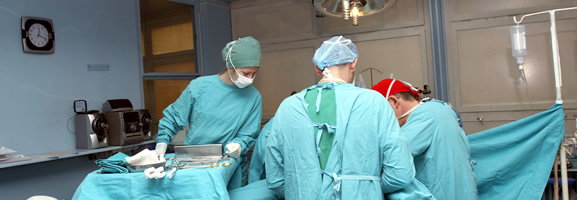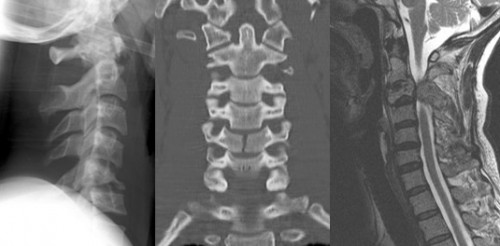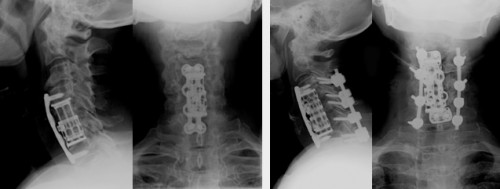Vertebrectomy means removal of the vertebral body, the major part of the cervical vertebra and is performed through the front of the neck.
Why?
One or more vertebral bodies within the cervical spine are removed by approaching the spine from the front of the neck. This is used to relieve the pressure on multiple nerve roots or the spinal cord, which may occur when the spine becomes degenerate, or as a result of a tumours or spinal fractures within the spine. Once the spine is decompressed it can then be stabilized using various techniques.
When?
Anterior cervical vertebrectomy may be performed when two or more adjacent intervertebral discs need to be removed, rather than performing Anterior Cervical Discectomy and fusion at multiple levels or if there is pressure on the spinal cord (Myelopathy) in the presence of severe kyphosis, (the neck is curved forward).
Severe fractures of the cervical spine or tumours can be removed from the front prior to stabilisation.
Prior to surgery
Prior to surgery you will be explained the natural history of the condition (what is likely to happen without treatment). Other treatment options will then be considered and the proposed procedure should be explained including the postoperative care and potential complications (see potential complication section), prior to you consenting to undergo the operation.
Surgery
A general anaesthetic is required and once this is administered a special head clamp is applied to the skull, using three small pins, to maintain the neck in the correct position throughout the operation.
The patient is positioned on their back to allow the surgery to be performed through the front of the neck with a scar along the length of the front of the neck. The vertebral body is then removed using a burr and the spinal cord is decompressed. Following this a metal cage, (hollow tube), is packed with bone graft and inserted in place of the vertebral body and held in place with a metal plate and screws which are placed into the adjacent vertebral bodies. Occasionally for long anterior fusions, a fusion needs to be added withan operation through the back of the neck. The longer the fusion, the more likely it is that a posterior fusion needs to. Generally a posterior fusion is done when three or more cervical bodies have to be removed, equivalent to four or more adjacent disc spaces.
Post operative care
There will be a drain (small tube), within the neck, which will remain there until the following morning. Patients may require a neck collar following surgery, usually for six weeks to three months, depending on the extent of the surgical procedure. Patients may mobilize their neck within the limits of comfort without fear of causing damage.
The following day you will be reviewed by your operating surgeon and the surgical drain will be removed. Following this you will be allowed to mobilise with the help of the physiotherapists.
Patients should expect some pain within the surgical site and it is not unusual to have aches and pains around the shoulders, as well as some discomfort on swallowing. The arm pain will have improved but may take some time following surgery to completely resolve as there may be some post operative swelling.
The skin clips should be removed at 7 to 10 days following surgery, usually about 12 days for the posterior surgical wound.
How long until I am better?
The recovery period varies greatly depending on the extent of the surgery and the reason for undergoing the procedure. This should be discussed with your treating surgeon prior to the procedure.







